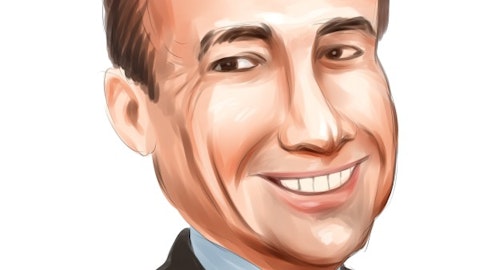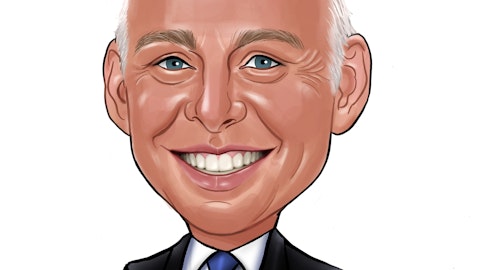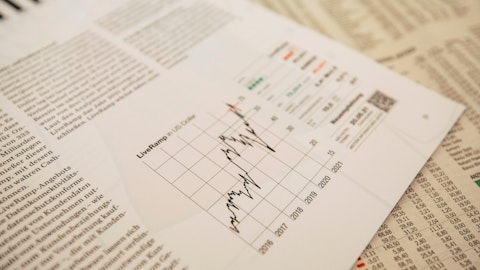Celestica Inc. (NYSE:CLS) Q4 2022 Earnings Call Transcript January 26, 2023
Operator: Good morning, ladies and gentlemen, and welcome to the Celestica Q4 2022 Earnings Conference Call. At this time, all lines are in listen-only mode. Following the presentation, we will conduct a question-and-answer session. This call is being recorded today, Thursday, January 26, 2023. I would now like to turn the conference over to Craig Oberg. Please go ahead.
Craig Oberg: Good morning, and thank you for joining us on Celestica’s fourth quarter 2022 earnings conference call. On the call today are Rob Mionis, President and Chief Executive Officer; and Mandeep Chawla, Chief Financial Officer. As a reminder, during this call, we will make forward-looking statements within the meanings of the U.S. Private Securities Litigation Reform Act of 1995 and applicable Canadian Securities Laws. Such forward-looking statements are based on management’s current expectations, forecasts and assumptions, which are subject to risks, uncertainties and other factors that could cause actual outcomes and results to differ materially from conclusions, forecasts or projections expressed in such statements.
For identification and discussion of such factors and assumptions, as well as further information concerning forward-looking statements, please refer to yesterday’s press release including the cautionary note regarding forward-looking statements therein, our most recent Annual Report on Form 20-F and our other public filings, which can be accessed at sec.gov and sedar.com. We assume no obligation to update any forward-looking statement except as required by law. In addition, during this call, we will refer to various non-IFRS financial measures including ratios based on non-IFRS financial measures, consisting of non-IFRS operating earnings, non-IFRS operating margin, adjusted gross margin, adjusted return on invested capital or adjusted ROIC, adjusted free cash flow, gross debt to non-IFRS trailing 12-month adjusted EBITDA leverage ratio, adjusted net earnings, adjusted earnings per share or adjusted EPS, adjusted SG&A expense, Lifecycle Solutions revenue, and adjusted effective tax rate.
Listeners should be cautioned that references to any of the foregoing measures during this call denote non-IFRS financial measures, whether or not specifically designated as such. These non-IFRS financial measures do not have any standardized meanings prescribed by IFRS and may not be comparable to similar measures presented by other public companies that report under IFRS or who report under U.S. GAAP and use non-GAAP financial measures to describe similar operating metrics. We refer you to yesterday’s press release and our Q4 2022 earnings presentation, which are available at celestica.com under the Investor Relations tab, for more information about these and certain other non-IFRS financial measures, including a reconciliation of historical non-IFRS financial measures to the most directly comparable IFRS financial measures from our financial statements.
Unless otherwise specified, all references to dollars on this call are to U.S. dollars, and per share information is based on diluted shares outstanding. Let me now turn the call over to Rob.
Rob Mionis: Thank you, Craig, and good morning, everyone, and thank you for joining us on today’s call. Celestica had a strong fourth quarter as we continue to drive solid performance despite continuing challenges presented by the macro environment. Our fourth quarter revenue of $2.04 billion and non-IFRS adjusted EPS of $0.56 were both above the high-end of our guidance ranges. In addition, our fourth quarter non-IFRS operating margin and non-IFRS adjusted EPS were the highest in the company’s history. 2022 was an extraordinary year for Celestica, where we achieved a number of important milestones. First, we returned to top line revenue growth on an annual basis for the first time since 2018, following the completion of a multiyear portfolio transformation initiative.
Revenue grew 29% overall and 24% organically compared to 2021, as we surpassed $7 billion in annual revenue for the first time since 2011. Second, we recorded our highest ever annual non-IFRS operating margin of 4.9% reflecting our ability to win and deliver on higher value added programs in alignment with our strategy. And finally, we achieved our highest ever annual non-IFRS adjusted EPS of $1.90, a 46% improvement compared to 2021. Our Lifecycle Solutions portfolio continues to be the primary driver of our both in revenue and profitability, reflecting our strategic focus on high value markets, where we see the long term tailwinds supporting sustainable growth. Our Lifecycle Solutions portfolio now represents roughly two-thirds of our business achieving 39% year-over-year revenue growth as both our HPS business and our ATS segment recorded their highest revenues ever in 2022.
Our ATS segment recorded 29% annual revenue growth coming in at approximately $3 billion in revenue in 2022. With our strategic diversification and exposure to markets with strong secular tailwinds, we expect strong growth fundamentals in ATS to continue in 2023. Our CCS segment also demonstrated substantial growth in 2022 recording 29% year-over-year revenue growth and segment margin of 5.1% the highest ever. Our strong CCS performance continues to be driven in large part by our HPS business, which achieved revenues of $1.83 billion in 2022, representing 59% year-over-year revenue growth. This growth has been supported by strong demand from our service provider customers for our differentiated offerings. We are confident that our strategic initiatives over the past several years focused on diversifying our business and growing our exposure to high value markets will help us sustain our trajectory of strong financial performance into 2023 and over the long term.
Before I offer some additional color on the outlook for each of our markets, I would like to turn the call over to Mandeep, who will provide details on our financial performance in the fourth quarter, as well as our guidance for the first quarter of 2023. Over to you, Mandeep.
Mandeep Chawla: Thank you, Rob, and good morning, everyone. Fourth quarter revenue came in at $2.04 billion. This exceeded the high end of our guidance range and was 35% higher year-over-year, supported by revenue growth across each of our businesses. We achieved fourth quarter non-IFRS operating margin of 5.3%, 40 basis points higher year-over-year. The strong performance was driven in large part by record profitability in our CCS segment and represented the highest quarterly non-IFRS operating margin in the company’s history. Non-IFRS adjusted earnings per share were $0.56 for the fourth quarter, above the high end of our guidance range and up $0.12 year-over-year, driven by higher volumes and improved mix. ATS segment revenue was up 30% year-over-year in the fourth quarter, higher than our expectations of a mid-20s percentage year-over-year increase.
Year over year growth in ATS segment revenue was driven by the strong performance of our Industrial and A&D businesses, supported by solid demand, new program ramps and improved materials availability. ATS segment revenue accounted for 40% of total revenues in the fourth quarter. Our CCS segment delivered another quarter of robust growth with revenue up 39% year-over-year driven by outperformance in both our Communications and Enterprise end markets. Our HPS business continues to deliver strong results recording revenues of $491 million in the fourth quarter, up 40% year-over-year. The growth in HPS revenue was driven by market share gains and strong demand from our service provider customers, as they have continued to make significant investments in expanding data center capacity.
HPS revenues were 24% of total company revenues in the fourth quarter up from 20% in 2021. Communications end market revenue was up 34% year-over-year just ahead of our expectations of a low-30s percentage increase, driven by program ramps in our HPS business and improved materials availability. Enterprise end market revenue in the quarter was up 49% year-over-year, well above our expectations of a mid-20s percentage increase, driven primarily by new RAC (ph) programs, increased demand in compute and improved materials availability. Turning to segment margins. ATS segment margin was 4.4% in the fourth quarter, 120 basis points lower year-over-year. The decline in segment margin was driven by late quarter demand shifts in capital equipment, compounded by a large number of ramping programs in Industrial, partially offset by sequential improvement in PCI.
Our expectation is for ATS segment margins to expand in the coming quarters. CCS segment margin of 5.9% was up 150 basis points year-over-year. The increase was driven by strong HPS mix and operational productivity, driven by improved material flow, strong service billings and volume leverage. Moving on to some additional financial metrics. IFRS net earnings for the quarter were $42 million or $0.35 per share, compared to net earnings of $32 million or $0.26 per share in the same quarter last year. Adjusted gross margin for the fourth quarter was 9.4% down 20 basis points year-over-year, primarily due to higher variable compensation. Our non-IFRS adjusted effective tax rate for the fourth quarter was 22.7%. Non-IFRS adjusted ROIC was 20.7% for the fourth quarter, up 4.1% year-over-year and our highest results since 2017.
Moving on to working capital. Our inventory at the end of the fourth quarter was $2.35 billion, up $24 million sequentially and up $653 million year-over-year. While the challenging supply chain environment has contributed and continues to contribute in driving up our inventory levels, a substantial portion of the increase is also attributable to our strong sales growth over the past two years. We continue to work collaboratively with our customers to help fund the growth in inventory as evidenced by over $800 million in customer cash deposits at the end of the fourth quarter, an increase of approximately $200 million sequentially and nearly $400 million year-over-year. When offsetting inventory by cash deposits, our inventory balance actually decreased by approximately $150 million compared to the previous quarter.
Cash cycle days were 64 during the fourth quarter, one day higher than the third quarter and 11 days lower than the prior year period. We are also seeing continuing signs of supply chain constraints improving, with fewer material constraints compared to previous quarters and early signs of material lead times being reduced from record levels. While we remain diligent and proactive, we do expect to see improvements in working capital in 2023. Capital expenditures for the fourth quarter were $32 million, or approximately 1.6% of revenue compared with 1.1% in the fourth quarter of 2021. This increase was in line with our previously communicated expectations for slightly elevated investment in the back half of the year. The increased expenditures were primarily to fund investments in our Southeast Asia and Mexico facilities in support of new program wins.

Photo by Yogesh Phuyal on Unsplash
Non-IFRS adjusted free cash flow was $43 million in the fourth quarter compared to $36 million in the prior year period. Fiscal 2022 non-IFRS adjusted free cash flow totaled $94 million, ahead of our expectations due to strong working capital management. Our expectations are to achieve at least $100 million in non-IFRS adjusted free cash flow in 2023, consistent with our long term goal. Moving on to some additional key metrics. Our cash balance at the end of the year was $375 million, down $19 million year-over-year and up $12 million sequentially. Our cash balance in addition to our approximately $600 million of borrowing capacity under our revolver, provide us with liquidity of approximately $1 billion, which we believe is sufficient to meet our anticipated business needs.
We ended the year with gross debt of $627 million down $20 million from the previous quarter, leaving us with a net debt position of $252 million. Our fourth quarter gross debt to non-IFRS trailing 12-month adjusted EBITDA leverage ratio was 1.3 turns, down 0.2 turns sequentially and down 0.7 turns compared to the same quarter of last year. At December 31, 2022 we were compliant with all financial covenants under our credit agreement. During the fourth quarter, we purchased approximately 1.2 million shares for cancellation at a cost of approximately $12 million. We repurchased a total of 3.4 million shares for $35 million for cancellation during 2022. In December of 2022, the TSX accepted our new NCIB program, which permits us to purchase up to 8.8 million shares over the next 12 months.
Our return on capital strategy remains consistent as we aim to return 50% of our non-IFRS adjusted free cash flow to shareholders and reinvest 50% into the business over the long term. Now turning to our guidance for the first quarter of 2023. Our first quarter revenues are expected to be in the range of $1.725 billion to $1.875 billion. If the midpoint of this range is achieved, revenue will be up 15% year-over-year. First quarter, non-IFRS adjusted earnings per share are expected to be in the range of $0.41 to $0.47 per share. If the midpoint of our revenue and non-IFRS adjusted EPS guidance ranges are achieved. Non-IFRS operating margin will be approximately 5.0%, which will represent an increase of 60 basis points over the prior year period.
Non-IFRS adjusted SG&A expense for the first quarter is expected to be in the range of $56 million to $58 million. We anticipate our non-IFRS adjusted effective tax rate to be approximately 21% for the first quarter, excluding any impact from taxable foreign exchange. Now turning to our end market outlook for the first quarter of 2023. In our ATS end markets, we anticipate revenue to be up in the low-single digit percentage range year-over-year, driven by double-digit growth in Industrial and A&D, partially offset by softer demand in capital equipment. In our CCS segment, we anticipate revenues in our communication end market to be up in the high-teens percentage range year-over-year, driven by continued strong demand from service provider customers, supported by our HPS offering.
Finally, in our Enterprise end market, we anticipate revenue growth in the mid-30 percentage range year-over-year, supported by strong demand in compute. I’ll now turn the call back over to Rob to provide additional color on our markets and our overall outlook.
Rob Mionis: Thank you, Mandeep. After a banner year for Celestica in 2022, I’d like to start-off by reaffirming our outlook for 2023, which we shared during our October conference call. To reiterate, our 2023 outlook is for revenue of at least $7.5 billion, while we are targeting non-IFRS adjusted EPS in the range of $1.95 to $2.05. These results if achieved would represent improvements on a year in which the company achieved record financial results in the areas of revenue, non-IFRS operating margin and non-IFRS adjusted EPS. Our anticipated 2023 non-IFRS operating margin range is between 4.5% and 5.5% up 50 basis points from 2022. While the broad market continues to be dynamic, we are confident in our planning and execution as well as the resiliency of our diversified portfolio.
We feel that our business is positioned to continue to outperform our broader markets and achieve strong financial results going forward. We are pleased that we are ahead of the non-IFRS adjusted EPS objectives we set in our March 2022 Investor Call, which was to grow non-IFRS adjusted EPS at 10% or more per year for 2022 through 2025. In 2022, we grew non-IFRS adjusted EPS substantially. And at the midpoint of the targeted range for 2023, our two year average annual growth rate would be 24% for 2022 and 2023. For 2024 through 2025, our average annual non-IFRS adjusted EPS growth rate objective continues to be 10% or more. To incentivize our continuing focus on driving profitable growth, we have restructured our long term incentive plan for senior executives by adding a non-IFRS adjusted EPS as a key performance measure.
Now, I’d like to turn to our outlook for each of our businesses. 2022 was a great year for both ATS and CCS. And we expect to build on that momentum in 2023, with ATS segment revenue growing in the high-single digits and CCS segment revenue growing in the low-single digits. In our ATS segment, our industrial business continues to post strong results with 24% organic growth in 2022 compared to 2021 with sequential improvement in each quarter throughout the year. Also, PCI continued to impress in 2022, as it posted strong operating results and exceeded our year one synergy targets. The outlook for our Industrial business remains robust. As demand is expected to continue to benefit from secular tailwinds in the green energy market, including electrical vehicles, where we are ramping a number of new programs.
We expect our industrial business to have strong growth in 2023 with approximately 75% of that anticipated growth coming from green energy programs. Turning to capital equipment. Our capital equipment business had solid performance in 2022, driven by secular demand, market share gains and strong operational execution. On our previous call, we highlighted the expectation for wafer fab equipment spending to reduce in 2023 after several years of rapid growth with the majority of the decline coming from the memory market. We are now seeing estimates for the overall wafer fab equipment market to decline by approximately 20% in 2023 with the majority of the decline still in memory. While the overall market is expected to be down materially, we anticipate our capital equipment revenues to be down slightly in 2023 compared to 2022.
The benefits of our business mix, market share gains and new program wins are expected to enable us to outperform the broader market. Looking beyond 2023, we are encouraged that the current market outlook anticipates the wafer fab equipment market to return to growth in 2024. Turning to A&D. Our A&D business saw a strong recovery in 2022 showing sequential improvement in each quarter and double-digit annual revenue growth. In our Commercial Aerospace business, we continue to see a normalization of commercial air traffic towards pre-COVID levels, a trend which is anticipated to continue through 2023. Revenue in our Defense business saw a double-digit growth in 2022 and is expected to maintain its solid trajectory in 2023, supported by increased military spending and investments in equipment upgrades from European and North American governments, amid rising geopolitical tensions.
Our HealthTech business is experiencing strong growth. Due to the nature of demand for healthcare goods and services, we believe the outlook for our HealthTech business is less sensitive to recessionary pressures. We anticipate year-over-year revenue growth in 2023, supported by new project ramps in surgical, imaging and patient monitoring devices. Now turning to our CCS segment. Our HPS business has exhibited remarkable growth over the past three years, posting an annualized growth rate of 56% more than tripling in size. The substantial capital investments in data set expansion made by our service provider customers and our ability to gain market share from ODMs with our differentiated offerings has supported this exceptional period of performance.
Based on our current market outlook, we expect to see a moderation of growth in service provider customer programs in 2023. This is primarily the result of more difficult comps after a record 2022, as well as a potential softening of demand in light of the current economic environment. Our expectation is for our HPS business to continue to see growth in 2023, however, at more moderate levels. Our outlook for our communications end market is aligned with that of our HPS business, given that it has been the primary driver of growth in recent quarters. We expect communications business to grow in 2023, but at more moderate levels due to tougher comps. Finally, in our Enterprise end market, we expect the business to grow in 2023 as a result of new program ramps but again at more moderate levels due to tougher comps.
I am very pleased with what we have accomplished in 2022 and have confidence in our ability to achieve our 2023 objectives. That confidence is underpinned by our portfolio diversification, investments we have made to support meaningful growth opportunities and our proven ability to consistently execute across our global network. I would like to close out the call, by acknowledging the efforts and accomplishments of our global team, who have tirelessly worked towards the implementation and execution of our vision. The successes over the past year would not be possible without their dedication. With that, I would now like to turn the call over to the operator for questions. Thank you.
See also 10 Cheap Solar Stocks To Buy and 15 Most Shorted Stocks Hedge Funds Are Buying.
Q&A Session
Follow Celestica Inc (NYSE:CLS)
Follow Celestica Inc (NYSE:CLS)
Operator: Thank you. Ladies and gentlemen, we will now begin the question-and-answer session. Your first question comes from Jim Suva from Citigroup. Please go ahead.
Jim Suva: Thank you so much for the details. My question is you have had tremendous success with sales to the cloud and hyperscalers (ph). Are you getting from that type of demand product? You mentioned that you expect enterprise, I believe you said it will grow towards the end of your prepared comments. But I’m just curious about kind of hyperscalers and cloud and are you seeing any competitive changes in that area? Thank you.
Rob Mionis: Hi, Jim. Thanks for the question. Broadly speaking with the hyperscalers and the cloud, what we’re seeing in the current environment is order visibility is back to kind of normal levels we’re seeing growth tempering for most products, some increasing due to expanded use cases, i.e. it could have been part of the back pain and now it’s part of the fabric. We’re seeing China hyperscalers doing a little bit of a reset and creating some demand softness. But on the flip side, we’re still seeing growth, more moderate growth though coming from just about all the hyperscalers China side. And we’re still seeing customers paying premiums for airfreight at lower levels than previous quarters, but still relatively strong given the current environment.
Jim Suva: Great. Thanks. And as a follow-up, are you seeing any competitive changes not just on the cloud hyperscalers, but like overall business, because it seems like during COVID, when nobody could get the golden screw or the missing key parts pricing was less competitive. I’m just wondering now that available is becoming supply more available. Is pricing changing at all in the industry? I know it’s always a competitive industry, but I’m wondering, or is the industry going to turn the page to be a lot more disciplined compared to some past cycles?
Rob Mionis: It’s a good question. Given the fact that a large majority of our CCS business is now HPS, and we’ve established ourselves as an innovative with exceptional execution. We’re not seeing, call it, extreme pricing pressure just because of the stickiness and the design nature of the products and services that we provide to our customers.
Jim Suva: Thank you so much for the details and clarifications and congratulations to you and all your teams.
Rob Mionis: Thanks, Jim.
Operator: Thank you. Your next question comes from Thanos Moschopoulos. Please go ahead.
Thanos Moschopoulos: Hi. Good morning. Rob, maybe just stepping back on the macro, obviously a dynamic environment. So if we think about just the change in what you’re seeing over the last three months. It sounds like, I mean, my takeaway from your commentary is that demand is kind of pretty consistent. Maybe with the exception of some softening incrementally in capital equipment’s and then supply chain showing some improvement versus last quarter. Would that be fair? I mean, just again thinking about changes versus last quarter, anything else you call out or are those the key takeaways?
Rob Mionis: Yeah, that’s right. So within ATS, we’re seeing growth across all the verticals with the exception being capital equipment and we expect that to be mildly down in 2023, largely driven by the fact that we have new program ramps and some of them are even with new lithography customers which shows that we’re actually diversifying our capital equipment customer base, which is a huge positive. And within CCS, frankly, the comps, so just really tough from 2022 going to 2023. But we are seeing growth across comps in Enterprise and HPS certainly into Q1 and for the full year.
Thanos Moschopoulos: And then on the CCS margins, which were obviously exceptionally strong. Any one time things that may benefited Q4 or is this kind of margin stream for sustainable as we think about the first half of the year?





